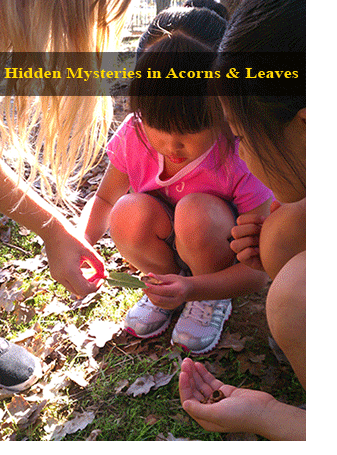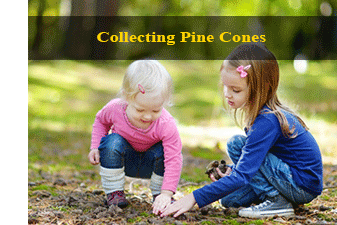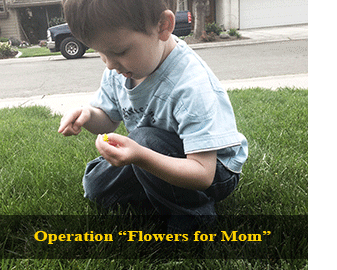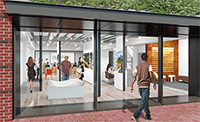|
|
Nature's Play Value Exposed
Author: Chad Kennedy, Landscape Architect, ASLA
 Anticipation was mounting as the group of children huddled closer, attempting to get a better look. Their labored journey and exhaustive search for treasure and discovery had led them to this very moment. In front of them, cradled in her hands, was an object of mystery and intrigue. Each child, with laser-like focus, watched as the abnormally large acorn was cracked open, revealing the contents hidden within. Mixed reaction occurred as the leathery shell casing was removed, exposing not only the cream colored soft seed tissue, but a host of little creatures feasting on it. Some children ran away in disgust, others fascinated by the revelation poked and prodded with interest until the acorn no longer resembled its original form. They had certainly found treasure, in one of its many creative forms. Anticipation was mounting as the group of children huddled closer, attempting to get a better look. Their labored journey and exhaustive search for treasure and discovery had led them to this very moment. In front of them, cradled in her hands, was an object of mystery and intrigue. Each child, with laser-like focus, watched as the abnormally large acorn was cracked open, revealing the contents hidden within. Mixed reaction occurred as the leathery shell casing was removed, exposing not only the cream colored soft seed tissue, but a host of little creatures feasting on it. Some children ran away in disgust, others fascinated by the revelation poked and prodded with interest until the acorn no longer resembled its original form. They had certainly found treasure, in one of its many creative forms.
I had the pleasure of viewing this dramatic childhood expedition (and developmental process) occur while accompanying my children and their cousins to a public park within a California foothill oak tree grove. The formal play structures located just on the other side of the fence, though used for active play, had no chance of competing with the creative and dramatic play afforded by the loose natural environments surrounding them. This article will not focus on the importance of loose play principals, though a previous article, "Loosen up! Improving Play Value Through Loose Play Elements", on this subject, is available online for further review. This article will, however, focus on the value that plants can bring to play in general, and will provide examples of what types of plants are most successful in public play environments.
Nature's Intrinsic Play Value
First and foremost, nature is always changing, providing children with renewable supplies of play materials, sensory experiences, and creeping critters. In essence, play areas integrated with natural elements are different and afford new experiences each time a child visits. Logically, this type of play area will retain its novelty over time encouraging more frequent visits. "Diverse play settings meet individual needs according to stages of development, learning styles, personality types, friendship patterns and culture."2 Research has also shown that children find symbolism in nature that directly correlates with creative play.1 Additionally, the inclusion of nature provides an educational experience promoting hands-on learning and exploration that often does not exist in traditional playgrounds. Exploration is a fundamental form of play and provides an innate draw to natural settings that is critical in helping a child understand the surrounding landscape. Natural features such as inert materials, landforms, seed pods, flowers, grasses, trees, insects and other wildlife are all curious specimens worthy of childlike exploration and investigation. The following paragraphs will provide examples of tough, non-toxic plants, that provide play value through three specific categories: fruiting bodies, leaves and sticks, and flowers.
Fruiting Bodies 
As illustrated in the story above, the fruiting bodies of plants are amazing elements of dramatic and exploratory play. Some of the many types of plant fruits appropriate for play areas include berries, drupes, catkins, seed pods or capsules, achenes, samaras, nuts and cones. Below are examples of plants that produce these types of fruits:
- Berries - India Hawthorne, Strawberry tree, Chinese Pistache, Heavenly Bamboo and Junipers
- Catkins - Alder and Birch trees
- Seed Pods - Honeylocust, Golden Rain Tree, Golden Chain tree, Catalpa, Redbud, Desert Willow, Palo Verde, Chitalpa, and Mimosa trees
- Achenes - Sycamore and Sweet-gum trees, dandelions, sunflowers
- Samaras - Maple, Ash, and Elm trees
- Nuts - Oak, Hornbeam, and Horse chestnut trees
- Cones - Pine, Spruce, Fir, Redwood and Hemlock trees and shrubs
Leaves and Sticks
In addition to fruiting bodies, some plants offer up great play value through other aspects, such as producing interesting leaf sizes, shapes and colors, as well as by production of other litter such as needles and twigs. All of these plant components can be used to stimulate dramatic and creative play such as spontaneous swashbuckling sword fights, fall leaf drop mazes, leaf crown crafts, and mini-military stick forts. Below are examples of plants that can produce these types of opportunities:
- Interesting Leaves - Catalpa, Sycamore, Maple, Oak, Horse Chestnut, Mimosa trees, African Iris, Phormium, Red-Hot Poker, Juniper, decorative grasses, Lamb's Ears, Cape's Rush, spineless Aloes, and Horsetails
- Needles - Pine, Spruce, Fir, Redwood and Hemlock trees and shrubs
- Sticks and twigs - Ash, Elm, Heavenly Bamboo and Willows
 Flowers and Petals Flowers and Petals
Other plants offer play value through the vibrant colors and shapes of their flowers. Flowers are effective at capturing the attention of the young and old, and are also great catalysts for exploratory and dramatic play. Children greatly enjoy collecting and delivering flowers. This should be considered an acceptable element of play and encouraged whenever possible. Below are examples of plants that can produce these types of opportunities:
- Interesting flowers - Red-hot Poker, Lavender, African Iris, Sage, Bleeding Heart plant, Crocus, California Poppy, Yarrow, Dandelions, Sunflowers, Society Garlic, Kangaroo Paw, Hardy Hibiscus, Rockrose, Rose Mallow, Butterfly Bush, Echinacea, and Fountain grasses
This discussion barely scratches the surface of the many play opportunities plants offer children and adults alike. Full-blown expeditions, filled with treasure and adventure, happen in play environments every day, all over the world. Hopefully, armed with this information, plants infused into these environments will provide the greatest potential for successful creative play. To learn more about related issues and other landscape architecture topics, please visit the publications section of our website by clicking here.
1-Julie M. Johnson. Design for Learning: Values, Qualities, and Processes of Enriching School Landscapes. Landscape Architecture Technical Information Series. Washington D.C. 2009.
2-Robin Moore. Et all. Creating & Retrofitting Play Environments: Best Practice Guidelines. Playcore Inc. and Natural Learning Initiative, College of Design. NC State University. 2009.
|
|
|
|
 Anticipation was mounting as the group of children huddled closer, attempting to get a better look. Their labored journey and exhaustive search for treasure and discovery had led them to this very moment. In front of them, cradled in her hands, was an object of mystery and intrigue. Each child, with laser-like focus, watched as the abnormally large acorn was cracked open, revealing the contents hidden within. Mixed reaction occurred as the leathery shell casing was removed, exposing not only the cream colored soft seed tissue, but a host of little creatures feasting on it. Some children ran away in disgust, others fascinated by the revelation poked and prodded with interest until the acorn no longer resembled its original form. They had certainly found treasure, in one of its many creative forms.
Anticipation was mounting as the group of children huddled closer, attempting to get a better look. Their labored journey and exhaustive search for treasure and discovery had led them to this very moment. In front of them, cradled in her hands, was an object of mystery and intrigue. Each child, with laser-like focus, watched as the abnormally large acorn was cracked open, revealing the contents hidden within. Mixed reaction occurred as the leathery shell casing was removed, exposing not only the cream colored soft seed tissue, but a host of little creatures feasting on it. Some children ran away in disgust, others fascinated by the revelation poked and prodded with interest until the acorn no longer resembled its original form. They had certainly found treasure, in one of its many creative forms.

 Flowers and Petals
Flowers and Petals 

